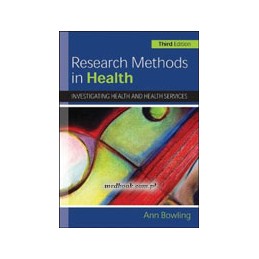- Obniżka


 Dostawa
Dostawa
Wybierz Paczkomat Inpost, Orlen Paczkę, DPD lub Pocztę Polską. Kliknij po więcej szczegółów
 Płatność
Płatność
Zapłać szybkim przelewem, kartą płatniczą lub za pobraniem. Kliknij po więcej szczegółów
 Zwroty
Zwroty
Jeżeli jesteś konsumentem możesz zwrócić towar w ciągu 14 dni. Kliknij po więcej szczegółów
Research Methods in Health provides a comprehensive guide to the variety of methods for studying and assessing health and health services. The book not only covers all the topics you need regarding research methods, but also looks into the wider aspects of health and health services. I especially liked the way the book didnt jump straight into research methods and methodology, but took time to introduce some of the main sociological and psychological concepts and ideas, as well as looking at demography and epidemiology ... Each chapter is introduced in easily understood terms and ends with the main points concisely summarized ... Throughout the book clear examples are very well used to build on our understanding of key concepts and at the end of the book is a very useful glossary of terms.
Conor Hamilton, Student Nurse, Queens University Belfast, UK
The additional information in this third edition, for example the coverage of mixed research methods and pertinent social science concepts makes the third edition of this book stand out as a preliminary source of information for anyone looking at research and health ... The summary of main points, key questions and key terms are outstanding and allow the book to be adapted into an essential revision tool as well as adding support and a focal point during reading the book.
Lisa Perraton, Student Nurse, University of Chester, UK
A very simplified text book of research that guides students through different research designs/methodologies. I think this book must be recommended to every research student.
Moses Murandu, Wolverhampton University, UK
This bestselling book provides an accessible introduction to the theoretical concepts and descriptive and analytic research methods used in research on health and health services. The third edition has been thoroughly revised throughout to include updated references and boxed examples, with additional information on key methodological developments, among them::
The book is grounded in the authors career as a researcher on health and health service issues, and the valuable experience this has provided in meeting the challenges of research on people and organisations in real life settings.
Research Methods in Health is an essential companion for students and researchers of health and health services, health clinicians and policy-makers with responsibility for applying research findings and judging the soundness of research.
Opis
Indeks: 43116
Autor: Beth Alder
An Illustrated Colour Text
